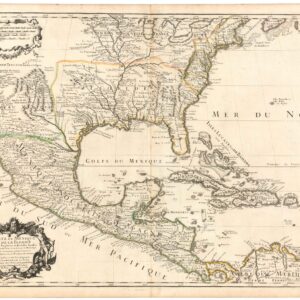From the creator of the dime-novel and the pulp fiction genre: this is Erastus Flavel Beadle’s rare and highly desirable map of the Great West.
A New Map of the Great West
$775
1 in stock
Description
Beadle’s excellent map of the Great Plains, Midwest, and the Rocky Mountains was originally issued in Jacob Ferris’ early travel companion, The States and Territories of the Great West, published in 1856 by Buffalo-based printers Miller, Orton & Mulligan. Due to its popularity, this work appeared in no less than five different editions, each with a copy of Beadle’s iconic fold-out map.
The map was naturally compiled as a reference to the book’s written content, although it does not allude to the text in any direct manner. Its scope extends from Ohio and the Great Lakes in the east to the Rocky Mountains in the west. It shows a range of states and territories delineated by thick blue lines, including Ohio, Indiana, Illinois, Michigan, Wisconsin, Iowa, Missouri, and Kansas. In the easternmost region of the map, parts of Pennsylvania and New York State are visible, though unlabeled.
Furthest to the west, we find the nascent Nebraska Territory, established only in 1854 and home to famous frontier settlements like St. Vrains, Fort Laramie, and Pueblo. Many sites on the map have gone down in history as part of the American story. Interestingly, Beadle’s brother and business partner resettled in Nebraska just as it was being formally established as a Territory, and his presence there may well have been a contributing factor in the care and detail this new part of the country was afforded on Beadle’s map.
Yet the inclusion of the Nebraska territory is but one manifestation of how Beadle incorporated recent political developments in America onto his map. Another is Kansas, which is rendered as open-ended in the west, allowing the Rockies to serve as its natural border. While this map was issued some years before the Colorado Gold Rush, it does label the regions that had been allocated to the Arapaho and Cheyenne tribes. South of the Kansas border, in what would later become Oklahoma, the label ‘Cherokee’ is worthy of note, as this also situates us in time. The Cherokee Tribe were originally from the American southeast, from places like Alabama, Georgia, Tennessee, and North Carolina. But in 1838, the US government forcibly relocated the entire Nation to a new ‘Indian Territory’ in Oklahoma, partly due to the discovery of gold on Cherokee lands.
In general, the map makes it evident that America’s boundaries were continuously pushing ever further west across the plains. In the eastern states, the infrastructure that came with modernization and full incorporation is made patently clear in the depiction of the railroad systems that connected the East Coast to the shores of the great western frontier, places like Wisconsin, Iowa, and Missouri. Once on the frontier heading west, stable river systems functioned as infrastructural arteries, allowing mobility, trade, and communication. The rivers were also equipped with frontier bastions and settlements and often associated with early wagon trails, as evidenced on our map.
A final element worthy of attention is the fact that Beadle traced the Missouri River and its many tributaries with great accuracy. Coalescing at St Louis, the riverine systems of the Upper Missouri constituted a network of navigable waterways that one could follow both west and northwest. Along the frontier, we also find iconic pioneer settlements such as Fort Manuel, established in 1806 by fur trader Manuel Lisa at the mouth of the Bighorn River. Fort Manuel was the first permanent, non-indigenous structure built in the region and, for decades, the only trading post in the Great Plains region. It consequently became a crucial node for American emigration into the Nebraska Territory and a stepping-stone for interaction with local tribes. By the time this map was published, however, Manuel and his St Louis Fur Company were long gone.
Cartographer(s):
Erastus Flavel Beadle (1821-1894) was an American printer and publisher. He was born in upstate New York, the grandson of Benjamin Beadle, a war hero in the American Revolution.
In 1838, Beadle apprenticed with H & E Phoney in Coopertown, New York, where he learned typesetting, stereotyping, engraving, and book-binding. In 1850 he set up a stereotype foundry with his brother and began focussing on publishing magazines. In 1860, the brothers relocated to Brooklyn and started a completely different type of publication: the paper-wrapped dime novels known as pulp fiction. The dime-novels became a huge hit, and in 1889 Beadle retired a millionaire.
Condition Description
Excellent.
References
Jacob Ferris (1854). The States and Territories of the Great West; Including Ohio, Indiana, Illinois, Missouri, Michigan, Wisconsin, Iowa, Minnesota, Kansas, and Nebraska; Their Geography, History, Advantage, Resources, and Prospects; Comprising Their Local History Institutions and Laws. Giving a Table of Distances, and the Most Direct Routes and Modes of Conveyance; Also, Pointing out the Best Districts For Agriculture, Commercial, Lumbering, and Mining Operations: With a Map and Numerous Illustrations, by Jacob Ferris. New York and Auburn: Miller, Orton, and Mulligan.




